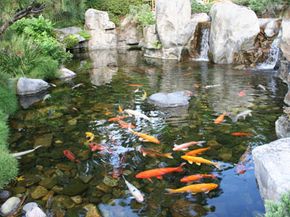Kinds of Ponds
There are different kinds of ponds just as there are different kinds of shrubs. One kind of bush blocks out unsightly views; another kind attracts butterflies. Ponds can be noisy, serene or vibrant with wildlife. They can support flashing koi or aromatic aquatic blooms. Think about what you'll enjoy the most -- fish, flowers, both?
Here are some general guidelines for koi ponds and water gardens:
Advertisement
Koi ponds need a large surface area and a depth of 3 to 4 feet (0.9 to 1.2 meters) in mild climates [source: Lowe's, Barber]. If you live in a very cold climate and want to overwinter your fish in the pond, you'll need to include a section of the pond that's deep enough to give the fish 12 to 16 inches (30.5 to 40.6 centimeters) of water below the ice layer [source: The Water Garden].
Koi ponds require a pump and filter system to remove fish wastes and keep the water clear and healthy. They generally don't have plants because the koi eat and otherwise destroy them, creating pond pollution. Koi ponds need shade to keep the fish cool and to prevent algae growth. Incorporating a current in the water by circulating it through a stream or waterfall forces the fish to exercise and stay healthy. In the absence of plants, this circulation is necessary to oxygenate (add oxygen to) the water.
Water gardens include aquatic plants and flowers, and may include a sprinkling of goldfish. The plants require several hours of sun each day to prosper and produce blooms. Water gardens can be small and only need 18 to 24 inches (45.7to 61 centimeters) of depth [source: Lowe's, Barber]. If you strike the perfect balance between fish and plants, you may not need a pump or filter system. Water plants don't like to be disturbed, so any current or inflow from a waterfall or fountain should be gentle.
Style comes into play next. Is your home and landscaping formal or informal? Water features in a formal setting tend to be geometric: square, rectangular, oval, L-shaped or circular. In an informal or natural setting, ponds can have a more irregular shape. Check out water features at local botanical gardens, garden tours and pond specialty stores for inspiration.
Other things to consider are your budget and the time and effort you want to put into building and maintaining your pond. Small ponds require more maintenance. Large ponds require more skill to build. Keep in mind that if you decide to get your feet wet with a small pond at first, you can always expand later by adding ponds and connecting waterways.
On the next page, we'll look what tools and supplies you need to build your pond.
